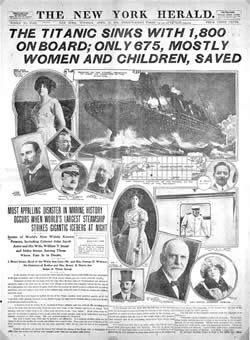Those who have been saved from Titanic disaster, have been saved through Mr. Marconi and his invention
Marchese Guglielmo Marconi (25 April 1874 – 20 July 1937) was an Italian inventor, best known for his development of a radiotelegraph system. Marconi began to conduct experiments, building much of his own equipment in the attic of his home at the Villa Griffone in Pontecchio, Italy. His goal was to use radio waves to create a practical system of "wireless telegraphy"—i.e. the transmission of telegraph messages without connecting wires as used by the electric telegraph. At first, Marconi could only signal over limited distances. In the summer of 1895 he moved his experimentation outdoors. After increasing the length of the transmitter and receiver antennas, and arranging them vertically, and positioning the antenna so that it touched the ground, the range increased significantly. Soon he was able to transmit signals over a hill, a distance of approximately 1.5 kilometres (0.93 mi).
Around the turn of the century, Marconi began investigating the means to signal completely across the Atlantic, in order to compete with the transatlantic telegraph cables. Marconi established a wireless transmitting station at Marconi House, Rosslare Strand, Co. Wexford in 1901 to act as a link between Poldhu in Cornwall and Clifden in Co. Galway. He soon made the announcement that on 12 December 1901, using a 152.4-metre (500 ft) kite-supported antenna for reception, the message was received at Signal Hill in St John's, Newfoundland (now part of Canada) signals transmitted by the company's new high-power station at Poldhu, Cornwall. The distance between the two points was about 3,500 kilometres (2,200 mi).
On 17 December 1902, a transmission from the Marconi station in Glace Bay, Nova Scotia, Canada, became the first radio message to cross the Atlantic from North America. On 18 January 1903, a Marconi station built near South Wellfleet, Massachusetts in 1901 sent a message of greetings from Theodore Roosevelt, the President of the United States, to King Edward VII of the United Kingdom, marking the first transatlantic radio transmission originating in the United States. However, consistent transatlantic signalling was difficult to establish. Marconi began to build high-powered stations on both sides of the Atlantic to communicate with ships at sea, in competition with other inventors. In 1904 a commercial service was established to transmit nightly news summaries to subscribing ships, which could incorporate them into their on-board newspapers. A regular transatlantic radio-telegraph service was finally begun on 17 October 1907 between Clifden Ireland and Glace Bay, but even after this the company struggled for many years to provide reliable communication.
Titanic
The two radio operators aboard the Titanic - Jack Phillips and Harold Bride - were not employed by the White Star Line but by the Marconi International Marine Communication Company. Following the sinking of the ocean liner, survivors were rescued by the Carpathia of the Cunard Line. Carpathia was sailing from New York City to Rijeka on the night of Sunday, 14 April 1912. Among her passengers were renowned American painters Colin Campbell Cooper and his wife Emma, journalist Lewis P. Skidmore, photographer Dr. Francis H. Blackmarr and Charles H. Marshall, whose three nieces were travelling aboard the Titanic. Carpathia was sailing from New York City to Rijeka on the night of Sunday, 14 April 1912. Among her passengers were renowned American painters Colin Campbell Cooper and his wife Emma, journalist Lewis P. Skidmore, photographer Dr. Francis H. Blackmarr and Charles H. Marshall, whose three nieces were travelling aboard the Titanic.
Her wireless operator, Harold Cottam, had missed previous messages from RMS Titanic, being on the bridge at the time. He received messages from Cape Race stating that they had private traffic for Titanic. He thought he would be helpful and sent a message to the Titanic stating that Cape Race had traffic for them. In reply he received a distress signal. Cottam awakened Captain Arthur Henry Rostron who immediately set a course at maximum speed to Titanic's last known position, approximately 58 miles (93 km) away. Rostron ordered the ship's heating and hot water to be cut off, so the engines could feed on every ounce of steam. At 4 o'clock in the morning Carpathia arrived at the scene after working her way through dangerous ice fields. Carpathia was able to save 705 people.
When it docked in New York, Marconi went aboard with a reporter from the New York Times to talk with Bride, the surviving operator. On 18 June 1912, Marconi gave evidence to the Court of Inquiry into the loss of the Titanic regarding the marine telegraphy's functions and the procedures for emergencies at sea. Britain's postmaster-general summed up, referring to the Titanic disaster, "Those who have been saved, have been saved through one man, Mr. Marconi...and his marvellous invention."

New York Herald front page about the Titanic disaster.
|